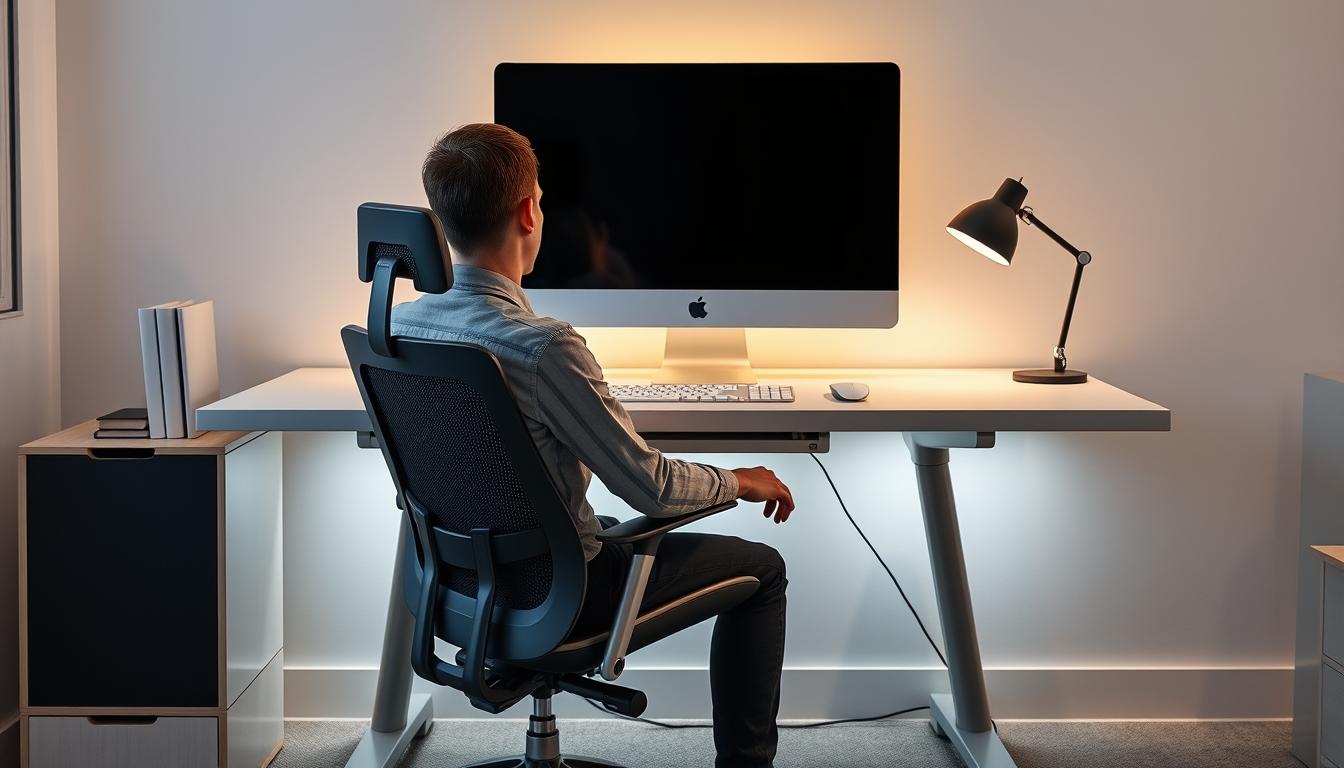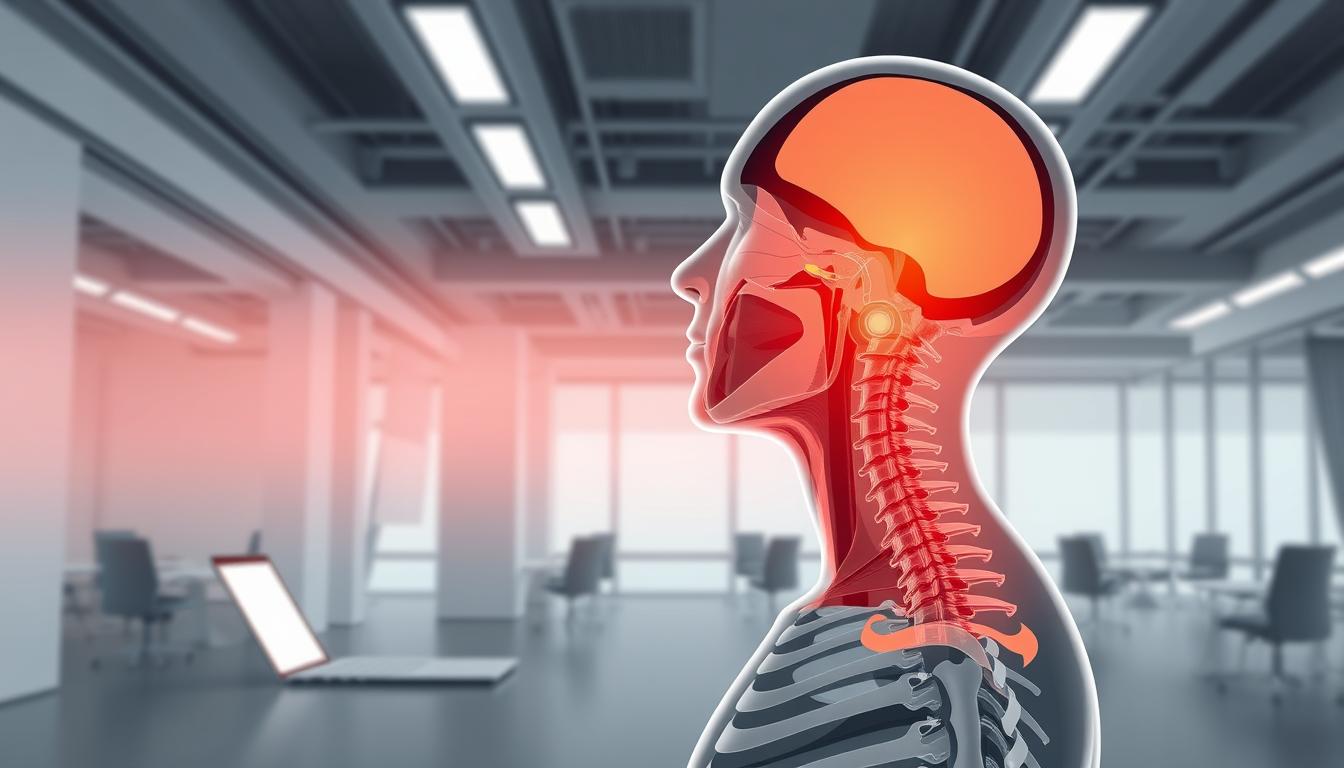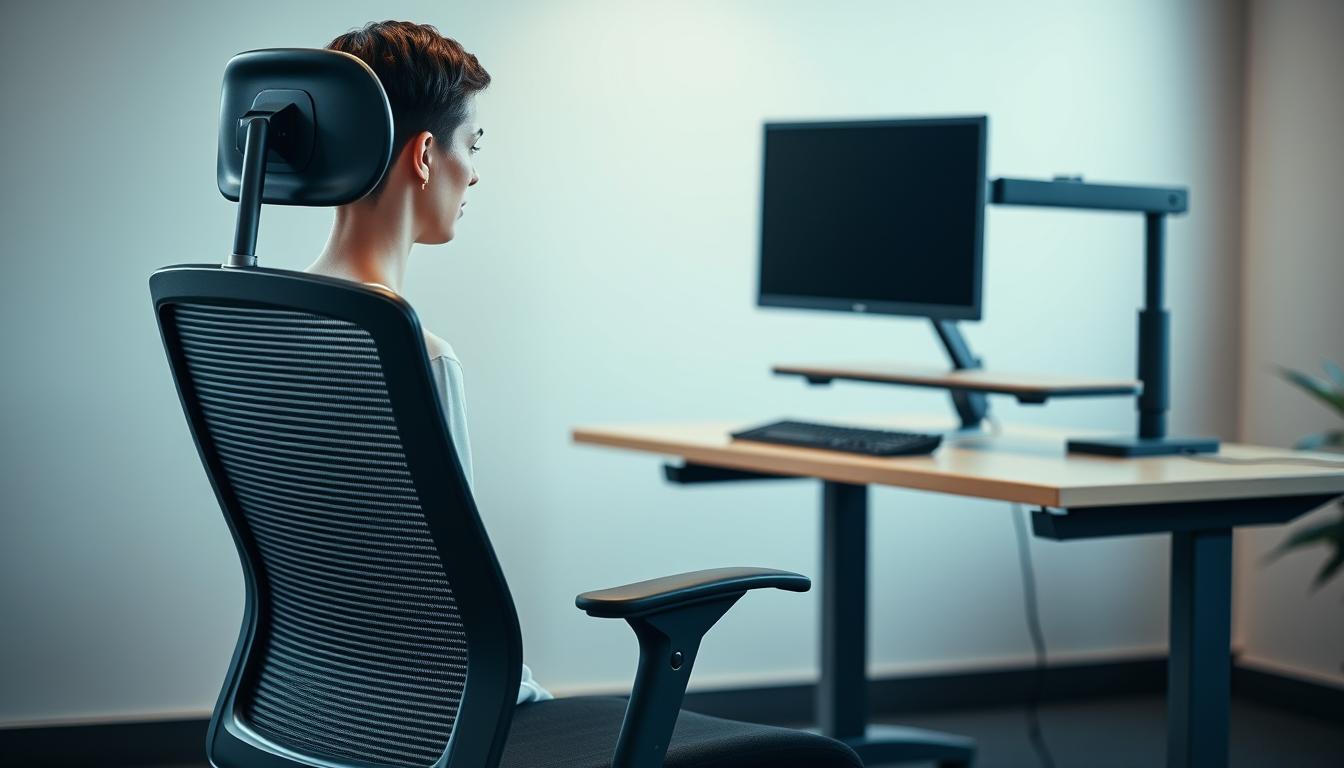Our daily lives often mean we sit a lot, so having the right workspace is key. An adjustable desk helps you have pain-free workdays. It lets you move between sitting and standing.
By focusing on good ergonomics, you stay comfortable and avoid things like neck strain and back pain. These problems are common if you sit too long.
The Importance of Ergonomics in a Workspace
An ergonomically set up workspace boosts comfort and productivity. It lets people work better with less strain. By tailoring workstations to meet individual needs, the mix of comfort and function is achieved.
Making your workspace ergonomic significantly cuts down physical discomfort chances. Good layouts lower the risk of injuries from doing the same motions over and over. They make a place where well-being is front and center. Workers are happier and miss fewer days due to discomfort when ergonomics guide their space.
Studies show that companies that embrace ergonomics see big gains in efficiency and morale. When teams have the right ergonomic tools, they focus better. This improves their work and helps build a healthier work atmosphere.
Understanding Office Ergonomics
Office ergonomics is key to a healthy workplace. It helps prevent health issues that come from bad work habits. Knowing about ergonomics is a must if you work long hours at a computer or do the same tasks over and over.
Health Risks of Poor Ergonomics
Poor office ergonomics can lead to health problems such as:
- Chronic neck and back pain
- Repetitive strain injuries
- Carpal tunnel syndrome
These problems can happen from bad posture or workspaces that don’t support the body properly. To stay healthy, it’s important for workers to practice good ergonomic habits.
Why Ergonomics Matter in Daily Tasks
Making ergonomics part of everyday tasks is crucial. It helps reduce the stress on your body. For example, keeping a straight posture while typing or using a mouse can make a big difference. This approach boosts comfort and efficiency, letting people work well without harming their health.
Choosing the Right Adjustable Desk
Choosing an adjustable desk can change your work area for the better. It’s key to look at features that make your space customizable and comfy. Make sure the desk can easily change height and stay stable for your needs.
Features to Look for in Adjustable Desks
Keep an eye on these important features:
- Motorized height adjustments for easy changes
- A sturdy frame to support your stuff
- Enough space for all your necessary items
Height Adjustment Options
There are different ways desks adjust height, depending on what you like. Think about these options for your desk:
- Manual systems, simple and cost-effective
- Electric systems for smooth height changes
Creating a Comfortable Chair Setup
Setting up a good chair is key for being comfy during long work hours. An ergonomic chair is vital, as it fits the curve of your spine just right. When looking for the perfect chair, think about several important features that keep you feeling good while sitting.
Choosing an Ergonomic Chair
When picking out an ergonomic chair, focus on features that offer good support and coziness. Search for a chair that has:
- Lumbar support to keep your spine in the right position.
- Adjustable seat height to suit different body sizes.
- Armrests that can be moved to ease shoulder tension.
Together, these features make sitting down for work enjoyable, so you can concentrate without feeling uncomfortable.
Adjusting Chair Height Correctly
To get your workspace just right, adjusting chair height is essential. Do it like this:
- Stand and keep your feet flat on the ground.
- Change the chair’s height so your knees form a right angle.
- Your hips should be a bit higher than your knees for good blood flow.
By following these steps to adjust your chair, you’ll feel more comfortable and keep a good posture all day.
Optimal Desk Arrangement for Efficiency
Having a good desk setup is key for a comfy work area. Put things you use a lot within easy reach. This stops the need for too much stretching or awkward moves.
Organizing your desk the right way can really help you do better at work. Here are some tips to keep your space tidy and effective:
- Put important stuff like pens, notepads, and gadgets close by.
- Make sure wires are neat to keep them from getting tangled.
- Use shelves to take advantage of vertical space and avoid a crowded desk.
- Add a good lamp to lessen eye stress when working long hours.
By using these ideas, your work area will be more efficient and comfy. A well-set desk helps you stay focused and do better in your job.
Essential Keyboard and Mouse Placement
Finding the right spot for your keyboard and mouse can make your work more comfortable. It’s important to set them up so they meet ergonomic standards. This helps stop wrist injuries. Here are some tips to make your workspace better for you.
Position and Reach for Comfort
Your keyboard should be at or just below the level of your elbows. This lets your forearms stay straight and level. Keeping your wrists straight stops them from getting sore. Your mouse should be close to your keyboard so you don’t have to stretch. You might need to change the height of your desk or chair to get it just right.
Using Wrist Rests to Prevent Injury
Adding wrist rests can help keep your wrists safe. They keep your wrists straight while you type and use your mouse. Make sure your wrist rest feels good and isn’t too high. Change things around until you can work without feeling sore or uncomfortable.
Adjustable Desk Setup for Pain-Free Workdays
An adjustable desk with sit-stand features can make your work space much better. It lets you move from sitting to standing easily. This helps avoid the bad effects of sitting too long. Moving around more can keep you energized, make circulation better, and stop stiffness.
Integrating Sit-Stand Functionality
Adding sit-stand features to your desk has lots of pluses. It makes you move during the day. Try setting reminders to change your position often to stay awake and not get tired.
Maintaining Good Posture while Switching Positions
It’s important to keep good posture with an adjustable desk to avoid discomfort. Make sure your screen is at eye level, whether you’re sitting or standing. Keep your shoulders relaxed, and your arms should be at your sides comfortably. When you stand, use your core to support your back and lessen strain.
Monitor Positioning and Eye Health
Putting your monitor in the right place is key to keeping your eyes healthy and avoiding neck pain during long work days. Your monitor should be set up an arm’s length away. The top of the screen needs to be at or just below eye level. This helps you sit straight without bending over or slouching.
Correct Monitor Height and Distance
It’s important to find the perfect height and distance for your monitor to prevent tired eyes. A well-positioned monitor keeps your head in a natural position, which is good for your neck and spine. Having the screen an arm’s length away reduces glare and keeps your vision clear, protecting your eyes from strain.
Avoiding Neck Strain with Proper Setup
The way you position your monitor can affect how your neck feels. A proper setup can help you keep your head balanced, which cuts down on neck and upper back pain. You might need to adjust your monitor now and then to stay comfortable throughout the day. Making these adjustments a priority means a healthier work environment, showing how important good setup is for everyday tasks.
The Role of Frequent Movement in Enhancing Comfort
Moving around during the workday boosts comfort and productivity. It reduces muscle tiredness and improves blood flow. This is key when you’re sitting for a long time.
Take short breaks every 30 to 60 minutes. Stand up, stretch, and move around. This helps avoid stiffness and keeps you focused and creative.
Incorporating Breaks into Your Workday
Here are some tips to include movement breaks in your day:
- Set reminders on your phone or computer to take a break.
- Stand up and stretch during phone calls.
- Walk around your workspace or to a different area during breaks.
- Incorporate quick exercises, such as calf raises or shoulder shrugs.
These easy steps make your work environment more active. They help you feel more comfortable and stay productive.
The Benefits of a Zero-Gravity Position
Using a zero-gravity position has lots of benefits, especially if you sit at a desk all day. It takes away the pressure on your spine, making you feel more comfortable while working. By spreading your weight evenly, it also lessens joint pain, a common issue from sitting too much.
The Altwork Station is a modern device that helps you switch to a zero-gravity position. This ergonomic tool makes it easier to feel relaxed while doing your daily tasks. Adopting this position can help you focus better, get more done, and improve your overall health.
Incorporating Organizational Tools in Your Workspace
More goes into creating an efficient workspace than just choosing comfy chairs and desks. Good organization is key to feeling comfy and staying productive. Using tools to organize your space helps keep important stuff close and cuts down on clutter.
Keeping Necessary Items Within Reach
Adding things like drawer dividers, desk trays, and ways to keep cables tidy makes a big difference. These tools help keep things you use a lot right where you can easily grab them. This means you won’t have to stretch or bend awkwardly, making you more comfy and helping you work better over time.
- Drawer dividers help sort your stuff so you can find what you need fast.
- Desktop trays stop papers from stacking up and causing a mess.
- Cable management systems keep wires untangled and make everything look neat.
Best Practices for Long-Term Desk Use
Creating a good work area for using your desk for a long time is key. These habits make you work better and help avoid discomfort and injuries.
Building Healthy Work Habits
To feel better and do better at work, add good work habits to your day. Think about these tips:
- Set reminders to take breaks often. This lets your body stretch and recover.
- Keep a good posture by setting up your chair and desk right.
- Drink water to stay sharp and energized during the day.
Managing Stress and Fatigue Throughout the Day
A routine for handling stress can make you feel better at your desk. Try these methods:
- Do deep breathing exercises to relax.
- Take short walks during breaks to clear your mind.
- Work in set times with short breaks to avoid getting too tired.

Conclusion
Making your workspace ergonomic is key to staying pain-free and productive. Invest in an adjustable desk and practice good ergonomics. This way, you can avoid discomfort and work better each day. A smart ergonomic setup helps you stay healthy and focused.
Choosing the right desk height, supportive chair, and correct monitor position is important. These changes make your workspace fit your body’s needs. They also promote a healthy workplace. Moving towards an ergonomic workspace means more comfort and a happier work life.



